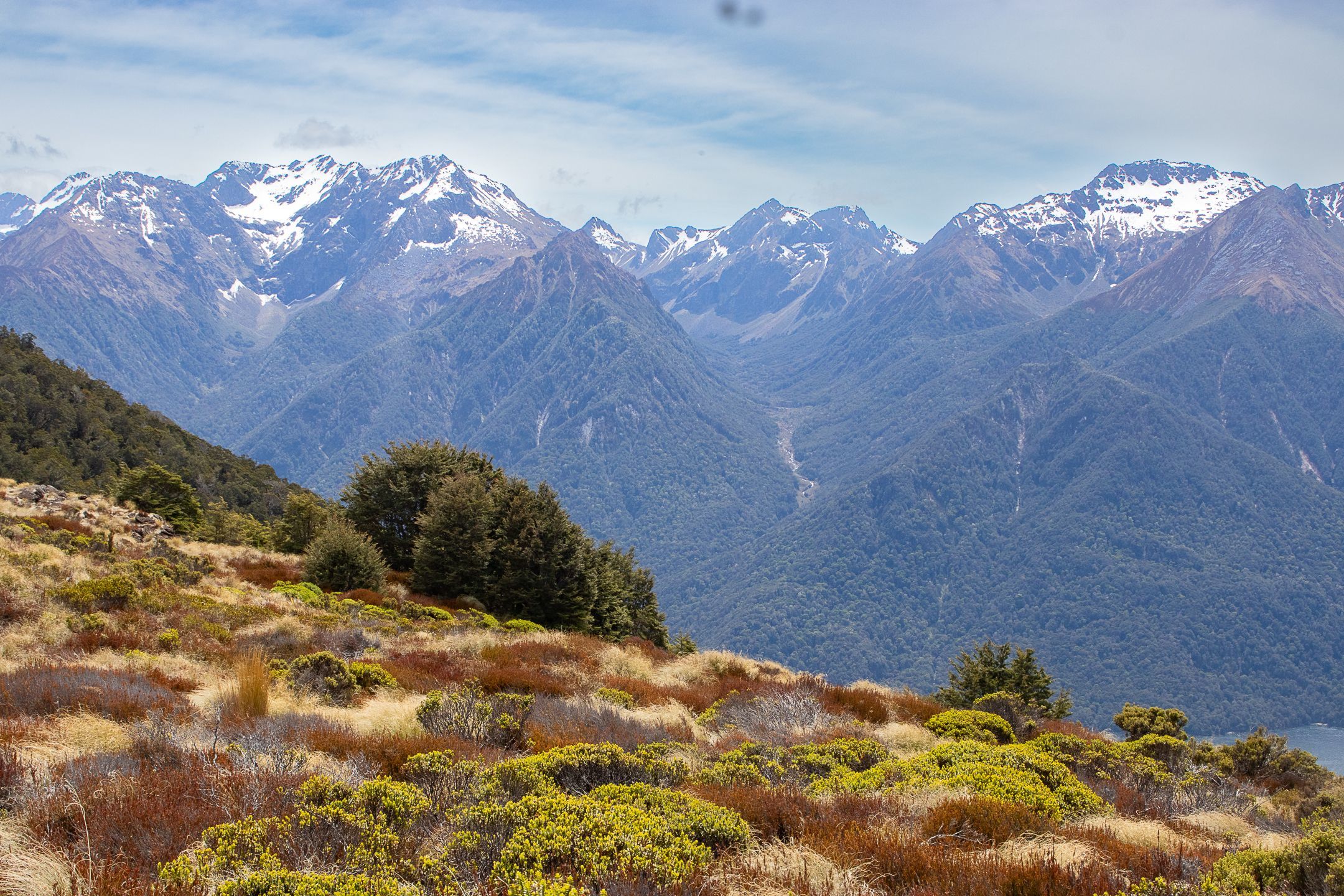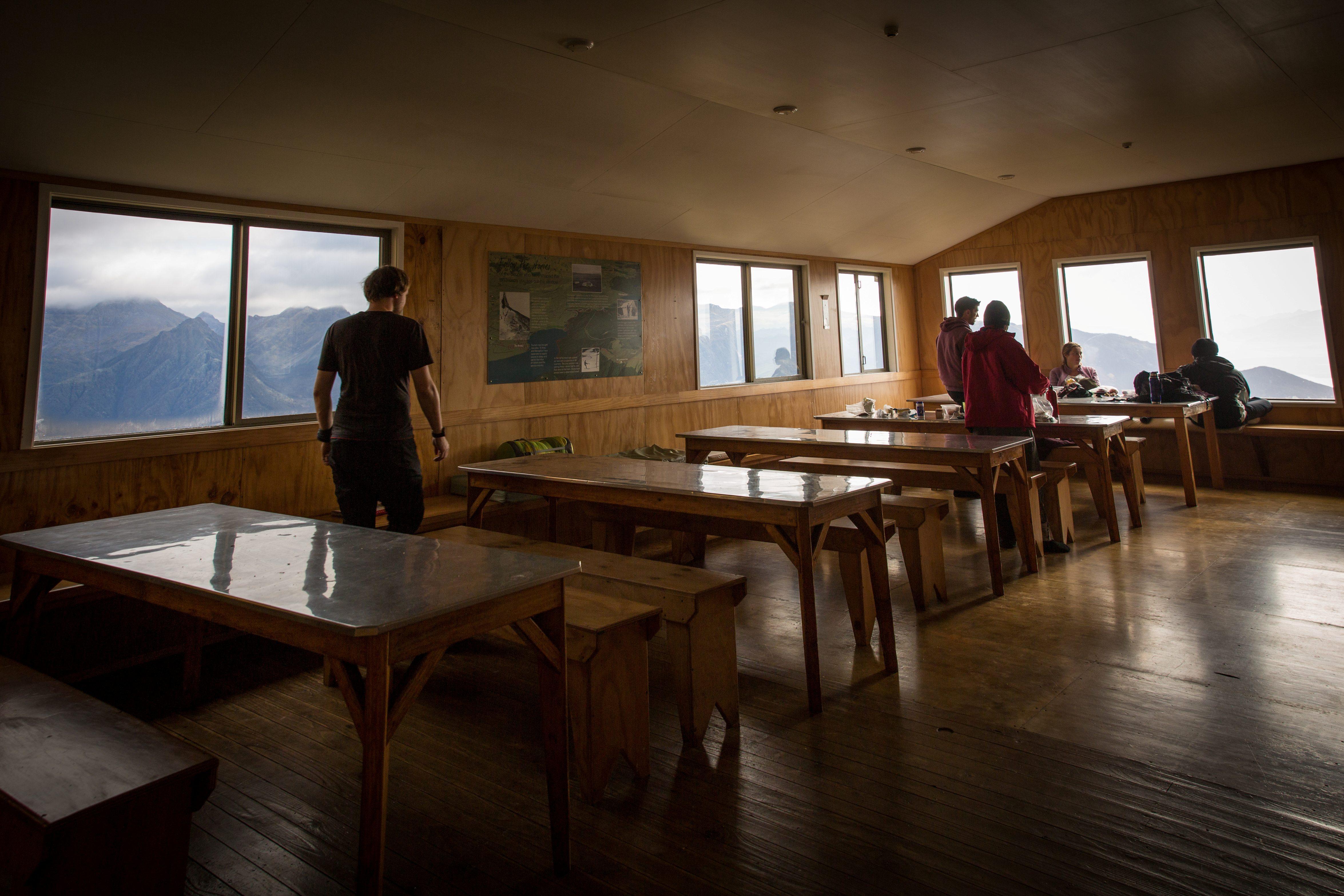Alpine Views, Native Forest and Lakeside Trails
The Kepler Track New Zealand is one of the most celebrated of the country’s Great Walks — a 60-kilometre loop through the heart of Fiordland National Park. Starting and finishing near Lake Te Anau, the trail takes in a spectacular variety of landscapes, from peaceful lakeshores to dramatic alpine ridgelines. Early on, the track climbs gently through beech forest before opening up to sweeping views across Lake Te Anau and the surrounding wilderness.
A standout highlight is Luxmore Hut, perched high above the tree line with breathtaking views and access to the nearby Luxmore Caves. As you traverse the ridges near Mount Luxmore, panoramic vistas of Fiordland unfold in every direction, offering countless opportunities for photography. It’s a true alpine experience without the need for technical gear, making it perfect for experienced hikers and fit, well-prepared first-timers alike.
Birdlife, River Valleys and Comfortable Huts
Beyond the high alpine terrain, the Kepler Track winds through mossy forest, cascading waterfalls, and the peaceful Iris Burn Valley. Wildlife lovers will be in their element — the trail is home to New Zealand’s native birds, including the playful kea, tui, bellbird, and tomtit. Along the Waiau River and Lake Manapouri, tranquil waters reflect the surrounding mountains, creating moments of serenity between the physical challenges.
The track features three well-maintained DOC huts: Luxmore Hut, Iris Burn Hut, and Moturau Hut. Each hut provides shelter, toilets, mattresses, and basic cooking facilities, along with stunning locations. Hikers must bring their own food, sleeping bag, and cooking equipment, but the setup is ideal for independent travellers who enjoy comfort without needing to carry a tent. With a clear path and excellent signage, the Kepler Track is one of the most accessible multi-day hikes in New Zealand’s national park system.
Top Things to Do on the Kepler Track New Zealand
- Hike the full 60km Kepler Track loop over 3–4 days
- Enjoy panoramic views from the Luxmore alpine ridgeline
- Stay in DOC huts: Luxmore, Iris Burn, and Moturau
- Explore the Luxmore Caves near Luxmore Hut
- Spot native birds like kea, tui, and bellbirds
- Walk along the shores of Lakes Te Anau and Manapouri
- Descend into the lush, mossy Iris Burn Valley
- Follow the Waiau River through peaceful forest sections
- Capture sunrise and sunset over Fiordland’s peaks
- Combine your walk with a visit to Te Anau’s bird sanctuary
The Kepler Track is a 60 km circular Great Walk located in the heart of Fiordland National Park, offering a perfect mix of alpine ridgelines, native beech forest, and lake and river valleys. Starting and finishing near Te Anau, this well-formed and clearly marked trail is ideal for those looking for a multi-day hike with diverse landscapes and fewer logistical challenges.
Typically walked over 3–4 days, the Kepler Track takes you along the shores of Lakes Te Anau and Manapouri, across tussock-covered mountaintops near Mount Luxmore, and through lush, mossy forest in the Iris Burn and Waiau River valleys. DOC huts and campsites are available along the track, making it suitable for independent hikers with a good level of fitness.
Kepler Track 4-Day Itinerary Overview
Day 1: Te Anau to Luxmore Hut (13.8 km, 5–6 hrs)
Start your hike at the Kepler Track car park near Te Anau. The track follows the lake edge through native beech forest to Brod Bay before climbing steadily above the bushline. You'll be rewarded with stunning panoramic views over Lake Te Anau and the surrounding mountains. The day ends at Luxmore Hut, located in an alpine setting near Mount Luxmore.
Day 2: Luxmore Hut to Iris Burn Hut (14.6 km, 5–6 hrs)
This section traverses exposed alpine ridgelines with dramatic views of the Kepler Mountains and Fiordland’s deep valleys. Descend through a beautiful alpine garden to the Iris Burn Valley, passing waterfalls and the Roaring Burn River. Iris Burn Hut is nestled in a large clearing, surrounded by native forest.
Day 3: Iris Burn Hut to Moturau Hut (16.2 km, 5–6 hrs)
Walk through lush forest and along river flats, crossing a low saddle before reaching the shores of Lake Manapouri. The trail winds through ancient beech and podocarp forest before arriving at Moturau Hut, set on a beach with spectacular lake and mountain views.
Day 4: Moturau Hut to Kepler Track Car Park (15.5 km, 4–5 hrs)
The final day begins in forest and opens out to wetlands on a raised boardwalk. Continue alongside the Waiau River to Rainbow Reach, where walkers can exit the track via swing bridge and shuttle back to Te Anau, or continue to the Kepler Track car park to complete the full loop.

Hiking the Kepler Track typically involves staying overnight in huts or campsites maintained by the New Zealand Department of Conservation (DOC). Here's what you need to know:
Huts: There are three huts along the Kepler Track – Luxmore Hut, Iris Burn Hut, and Moturau Hut. These huts are equipped with mattresses, heating, toilets, basic cooking facilities, solar-powered lighting, and a local ranger. You need to bring your own cooking utensils, sleeping bag, and food. Booking in advance is essential, especially during the peak season (late October to late April).
Campsites: Two campsites are available for those who prefer camping – one near the Luxmore Hut and another near the Iris Burn Hut. Each campsite has a toilet, water supply, and picnic tables, but you'll need to carry your own camping gear, including a tent. Like the huts, these campsites must be booked in advance during the Great Walks season.
Fees: Fees for the huts and campsites vary. Discounts are available for children and New Zealand residents. Always check the DOC website for the most current information.
Hut Etiquette: It's important to respect others sharing the huts with you. Keep noise to a minimum, especially in the evenings, clean up after yourself, and follow any rules posted by the DOC.
Safety: All huts and campsites are in remote areas with minimal phone reception. You should always let someone know your hiking plans before you set off and check in with the DOC visitor centre.
Lastly, remember that booking early is key as the Kepler Track is one of New Zealand's most popular Great Walks and availability can be limited, particularly during the summer months.

Accessing the Kepler Track and navigating around it can be achieved through various modes of transportation:
Getting There: The Kepler Track begins and ends near the town of Te Anau, which is approximately a 2-hour drive from Queenstown or a 2.5-hour drive from Invercargill. If you are not driving, there are regular bus services from these cities to Te Anau. The closest airports to Te Anau are in Queenstown and Invercargill.
On the Track: The Kepler Track is a loop, meaning you start and end at the same point, and can walk it in either direction. However, most people choose to start at the control gates near Te Anau, walking the track in a clockwise direction.
Exiting Early: For those who prefer not to complete the full loop, there's an exit point at the Rainbow Reach car park, cutting the track short by about 9.5 km. A shuttle service runs from Rainbow Reach back to Te Anau during the Great Walks season (late October to late April).
Boat Services: Another unique way to start or finish the track is by taking a boat across Lake Te Anau. Some hikers choose to take a boat to Brod Bay and start the track from there, or to finish their hike at Brod Bay and boat back to Te Anau.
Remember to check transport schedules in advance, especially if you plan to use shuttle services or boats, as these can be seasonal or weather dependent. As always, make sure to check the local weather forecasts and track conditions before setting out on your journey.
The Kepler Track and its surrounding areas are not just treasured for their natural beauty but also for their cultural and historical significance. Here are some highlights:
Māori Heritage: Before European settlement, the Fiordland area was visited by Māori hunters and gatherers. Lake Te Anau, which the Kepler Track skirts, is named after a Māori word "Te Ana-au," which means 'the cave of swirling water'. The Māori hunted birds like the moa and collected prized pounamu (greenstone or jade) in the area. Many place names in the region have Māori origins, reflecting the longstanding cultural ties to the land.
European Exploration: The region was explored by Europeans in the 19th century, primarily for surveying and prospecting purposes. Fiordland's rugged terrain made settlement challenging, and it remains one of the least populated parts of New Zealand.
Development of the Track: The Kepler Track was developed in the late 1980s as a response to overcrowding on other tracks in the area. It was purposely designed as a circular track to improve hiker flow and minimize environmental impact, marking an important milestone in sustainable trail development in New Zealand.
Bird Conservation: Fiordland is a critical area for bird conservation in New Zealand. The discovery of the takahe, a flightless bird thought to be extinct for 50 years, in the Murchison Mountains near the Kepler Track, led to important conservation efforts to protect this endangered species. The Kepler Track area remains a crucial habitat for the takahe, as well as many other native bird species.
The cultural and historical significance of the Kepler Track adds another layer of depth to the hiking experience, connecting walkers not just with the land, but also with the heritage of the people who lived on and cared for this land before them.
The Kepler Track can be hiked year-round, but the conditions and experiences can vary significantly depending on the season. Here's what to consider:
Great Walks Season (Late October - Late April): This is the busiest time on the Kepler Track. The track is well-maintained, all huts and campsites are fully operational, and the weather is generally more predictable and warmer, although rain can occur at any time. During this season, you must book huts and campsites in advance through the Department of Conservation.
Winter Season (May - October): The Kepler Track is less crowded during the winter, but the conditions are also more challenging. Parts of the track, especially the alpine sections, can be covered in snow and ice, making navigation difficult and requiring special equipment like crampons and ice axes. Avalanches can also be a risk. The huts remain open but operate on a first-come, first-served basis, and services are reduced.
Spring and Autumn: These shoulder seasons can offer a balance between fewer crowds and milder weather. However, unpredictable weather changes, including late snow in spring or early snow in autumn, can occur.
No matter what time of year you plan to hike the Kepler Track, always check the local weather forecasts and track conditions before you set off. Be prepared for changeable weather, and make sure you have the necessary skills and equipment for the conditions you are likely to encounter. Remember, your safety is your responsibility.
